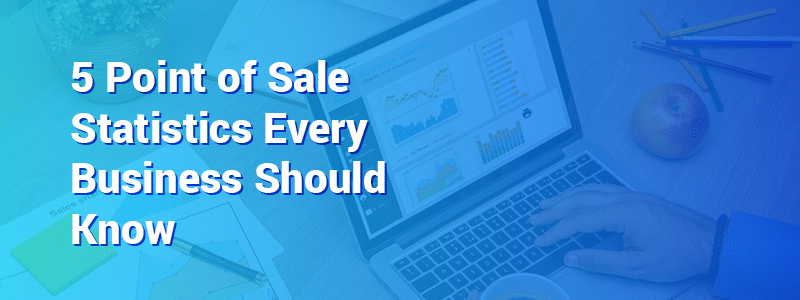When you’re making decisions for your business—especially when it comes to your payment processing strategy and point of sale (POS) system—you want the most up-to-date and accurate information possible. Anecdotal stories can be convincing, but without statistics backing them up, they’re simply hearsay.
In this guide, we’ve compiled a list of pressing POS questions and recent statistics about those questions to make sure you have the latest information. We’ll cover information about the following questions:
- How Secure Is My POS System?
- How Do Customers Want to Pay?
- How Should I Process Invoices?
- Is My Web Store Up to Par?
- How Do I Keep My Customers?
From dive shops to craft stores, whether you’re in the market for a new POS system or simply looking to make better use of your existing one, use key statistics to guide your decisions, processes, and strategies. We’ll start at the most critical element of any system: its security.
How Secure Is My POS System?
Before you get into making sales and promoting your organization with your POS system, you need to ensure it’s protecting both your customers and your business from harm.
Statistic 1: In 2021, there were 1,862 successful business data breaches, the highest yearly total in recorded history.
Both small and large businesses are at risk of their data being breached, stolen, or otherwise compromised. To minimize risk and the accompanying fallout, choose a reputable POS system that:
- Encrypts all personal and sensitive customer data.
- Adheres to payment card industry (PCI) regulations and standards.
- Uses a secure network for all transactions.
On the other hand, a faulty POS system runs the risk of being hacked and, as a result, causing irrevocable damage to your reputation and customer relationships. While maintaining a high level of security should be top of mind, the right POS system should make that process easy.
How Do Customers Want to Pay?
Don’t expect your customers to adapt their behavior to fit your POS system. Instead, meet your customers where they are. In this age of constantly evolving technology, customers all but expect to be able to pay at a moment’s notice with digital tools.
Statistic 2: 86% of consumers see instant payments as beneficial, helping them prevent late fees, budget better, and more easily complete payments.
If payment processing is slow, your customers may have doubts about their purchases and cancel their orders. Moreover, customers have different payment preferences. Offering only one payment option limits who will end up completing a purchase. Instead, consider offering additional payment options such as:
- Digital Wallet. Rapidly increasing in popularity, digital wallets allow customers to pay with a “tap to pay” app on their phones that holds virtual versions of their credit cards. Not only does this enable customers to make “contactless” payments, but it also saves them from having to dig through their wallets in search of the right card. Choose a processing system that can accept this type of payment.
- BNPL. An acronym for “buy now, pay later,” BNPL is a type of flexible payment plan that allows consumers an interest-free way to spread out their payments across multiple installments. Particularly for high ticket items that result in cart abandonment, BNPL is an excellent way to decrease sticker shock.
By not offering these payment types as options, you cut your business off from a large section of the marketplace. You can also mention these payment options in your marketing outreach as a way to attract new, hesitant customers.
How Should I Process Invoices?
If you’re processing your invoices and associated payments by hand, you’re wasting an incredible amount of time and money.
Statistic 3: Businesses that use paper invoices spend an average of $171,000 a year on associated processing costs.
This is reason enough for you to consider switching to digital tools to automate your invoices and collect payments. Moreover, paper invoices can easily get lost and will regularly include incorrect amounts. Inevitably, this slows down processing and can result in late or missing payments—by no fault of your customers!
Ultimately, by automating your invoices and sales, you’ll save resources that you can spend on earning new customers, retaining old ones, and helping your business grow.
Is My Web Store Up to Par?
Whether your customers are at home or in the office, on their computers or their phones, your website is the go-to place for customers to make online purchases. If your online store is easy for visitors to use, you’re more likely to convert them to paying customers.
Statistic 4: 9 out of 10 customers choose their preferred retailer primarily based on convenience.
Luckily, it’s quite easy to update your online store to engage customers and take them through the sales process. According to DNL OmniMedia’s guide to website accessibility, consider your webshop’s:
- Page speed. Nobody likes to wait in long lines to make a purchase. Slow load times are the digital equivalent. For faster load times, reduce picture size and refrain from too many URL redirects.
- Mobile-friendliness. Is it easy for your customers to make purchases from their phones? It should be! With so many smartphone users out there, your webshop should adapt to any screen size.
- Accessibility. Make your site easy to use for everyone. That way, you’re not excluding any potential customers. It should allow for adaptable contrast and text size, alt text for images, and screen reading capabilities.
- CTA buttons. Do you have a meaningful way to convert interested visitors into dedicated buyers? If you don’t show visitors what to look for, they may not find it. Add buttons that highlight sales, discounts, and other opportunities and take users through the sales funnel.
Your chosen POS system should integrate with your website, sync with your in-store inventory, and offer clear, streamlined steps for customers to make individual and recurring purchases without sending them on a journey from one website to another.
How Do I Keep My Customers?
Retaining customers is crucial for the success of nearly every business out there. While this will take more than an impactful, all-in-one POS system, it’s undoubtedly an excellent place to start.
Statistic 5: Every 5% increase in customer retention yields a 25% to 95% increase in a business’s profit.
On the flip side, losing customers and having to replace them constantly can be quite costly. But how do you achieve gains in retention and avoid churning customers?
When your customers have an easy, happy buying experience, they’re more likely to return year after year. In fact, this can matter even more than the product itself. On the flip side, many customers will gladly take their business to a competitor due to a single bad buying experience.
Be sure you’re offering your customers a good experience with your webshop, making it easy to engage from the minute they arrive to after checking out.
To put yourself in the best position for providing a positive customer experience, you can leverage your POS system’s features in the following ways:
- Store customer data to feed them the best deals and updates. For the most meaningful communications, follow data hygiene best practices and remove duplicate, inaccurate, and outdated information.
- Add value with loyalty programs. Reward repeat customers with a loyalty program that offers customers discounts or gift cards after making a certain number of purchases. You can use your POS system to keep track.
- Ask for feedback and reviews. Target recent customers with an automated email requesting their feedback. Show that you’re listening by adapting to customer suggestions and responding positively to praise and criticism.
Additionally, Rain POS recommends using a POS provider that “understands the vertical characteristics of your industry and designs software to cater to those unique needs through an all-in-one retail POS system.”
Essentially, you should be sure to use software built to address your organization’s specific niche rather than a generic audience.
In the end, don’t let your business become just another statistic. Instead, look for ways to stand out and differentiate yourself from your competition. A well-built, customizable POS system can help you earn your customers’ support and develop lifelong relationships. As trends and technology change, your POS system provider should provide updates based on both the current and forecasted industry trajectory.


















